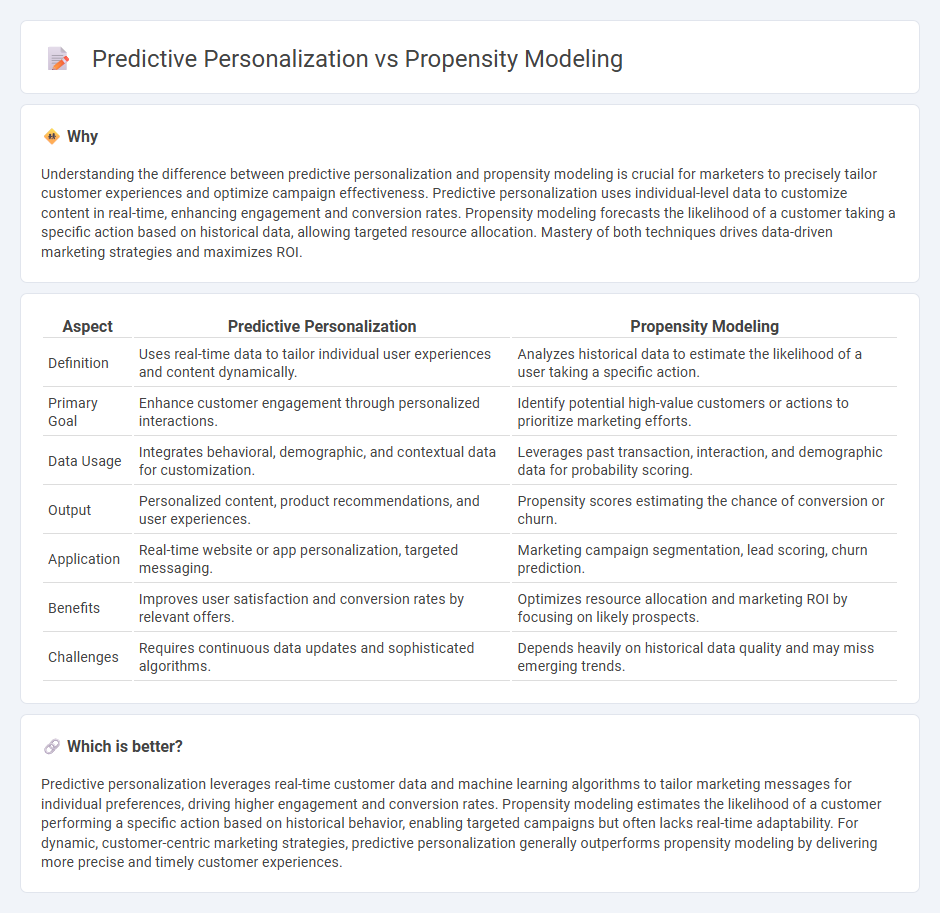
Predictive personalization uses machine learning algorithms to tailor marketing messages to individual customer preferences based on historical data and behaviors. Propensity modeling forecasts the likelihood of a customer taking a specific action, such as purchasing or subscribing, by analyzing patterns in demographic and transactional data. Explore these strategies to enhance customer engagement and optimize marketing ROI.
Why it is important
Understanding the difference between predictive personalization and propensity modeling is crucial for marketers to precisely tailor customer experiences and optimize campaign effectiveness. Predictive personalization uses individual-level data to customize content in real-time, enhancing engagement and conversion rates. Propensity modeling forecasts the likelihood of a customer taking a specific action based on historical data, allowing targeted resource allocation. Mastery of both techniques drives data-driven marketing strategies and maximizes ROI.
Comparison Table
| Aspect | Predictive Personalization | Propensity Modeling |
|---|---|---|
| Definition | Uses real-time data to tailor individual user experiences and content dynamically. | Analyzes historical data to estimate the likelihood of a user taking a specific action. |
| Primary Goal | Enhance customer engagement through personalized interactions. | Identify potential high-value customers or actions to prioritize marketing efforts. |
| Data Usage | Integrates behavioral, demographic, and contextual data for customization. | Leverages past transaction, interaction, and demographic data for probability scoring. |
| Output | Personalized content, product recommendations, and user experiences. | Propensity scores estimating the chance of conversion or churn. |
| Application | Real-time website or app personalization, targeted messaging. | Marketing campaign segmentation, lead scoring, churn prediction. |
| Benefits | Improves user satisfaction and conversion rates by relevant offers. | Optimizes resource allocation and marketing ROI by focusing on likely prospects. |
| Challenges | Requires continuous data updates and sophisticated algorithms. | Depends heavily on historical data quality and may miss emerging trends. |
Which is better?
Predictive personalization leverages real-time customer data and machine learning algorithms to tailor marketing messages for individual preferences, driving higher engagement and conversion rates. Propensity modeling estimates the likelihood of a customer performing a specific action based on historical behavior, enabling targeted campaigns but often lacks real-time adaptability. For dynamic, customer-centric marketing strategies, predictive personalization generally outperforms propensity modeling by delivering more precise and timely customer experiences.
Connection
Predictive personalization leverages propensity modeling to anticipate customer behaviors and tailor marketing efforts accordingly. By analyzing historical data, propensity models estimate the likelihood of specific actions, enabling marketers to deliver personalized content and offers that resonate with individual preferences. This connection enhances campaign effectiveness and maximizes customer engagement through data-driven insights.
Key Terms
Propensity Modeling:
Propensity modeling uses statistical techniques and machine learning algorithms to predict the likelihood of a customer taking a specific action, such as making a purchase or churning. It analyzes historical data and customer behavior patterns to assign probability scores that enable targeted marketing and resource allocation. Explore more about how propensity modeling can enhance predictive analytics and business decision-making.
Likelihood Score
Propensity modeling generates a likelihood score by analyzing historical data to predict customer behavior such as purchase or churn probability. Predictive personalization leverages this likelihood score to tailor marketing messages and offers, enhancing engagement and conversion rates with individualized experiences. Explore how integrating propensity models with personalization strategies can maximize customer lifetime value and campaign effectiveness.
Target Segmentation
Propensity modeling identifies the likelihood of individual customers engaging in specific behaviors, enabling precise target segmentation based on predicted actions. Predictive personalization tailors marketing messages and offers to segmented groups by leveraging these predictions to enhance customer experience and conversion rates. Explore more to understand how integrating these approaches can optimize your target segmentation strategy.
Source and External Links
An introduction to propensity modeling - Proove Intelligence - Propensity modeling refers to statistical methods used to predict how likely specific user actions are to lead to events like purchases by analyzing behavioral data, often through regression or machine learning models.
Propensity Modelling: Definition, types and use cases | Impression - It is a marketing tool that scores customers based on data to predict future actions using techniques like logistic regression, decision trees, or neural networks, choosing features according to desired outcomes.
Propensity Modeling - Netcore Cloud - This method employs statistical and machine learning algorithms to estimate the probability of customer actions such as purchasing or churn, allowing targeted and efficient marketing through scores like conversion likelihood.
 dowidth.com
dowidth.com